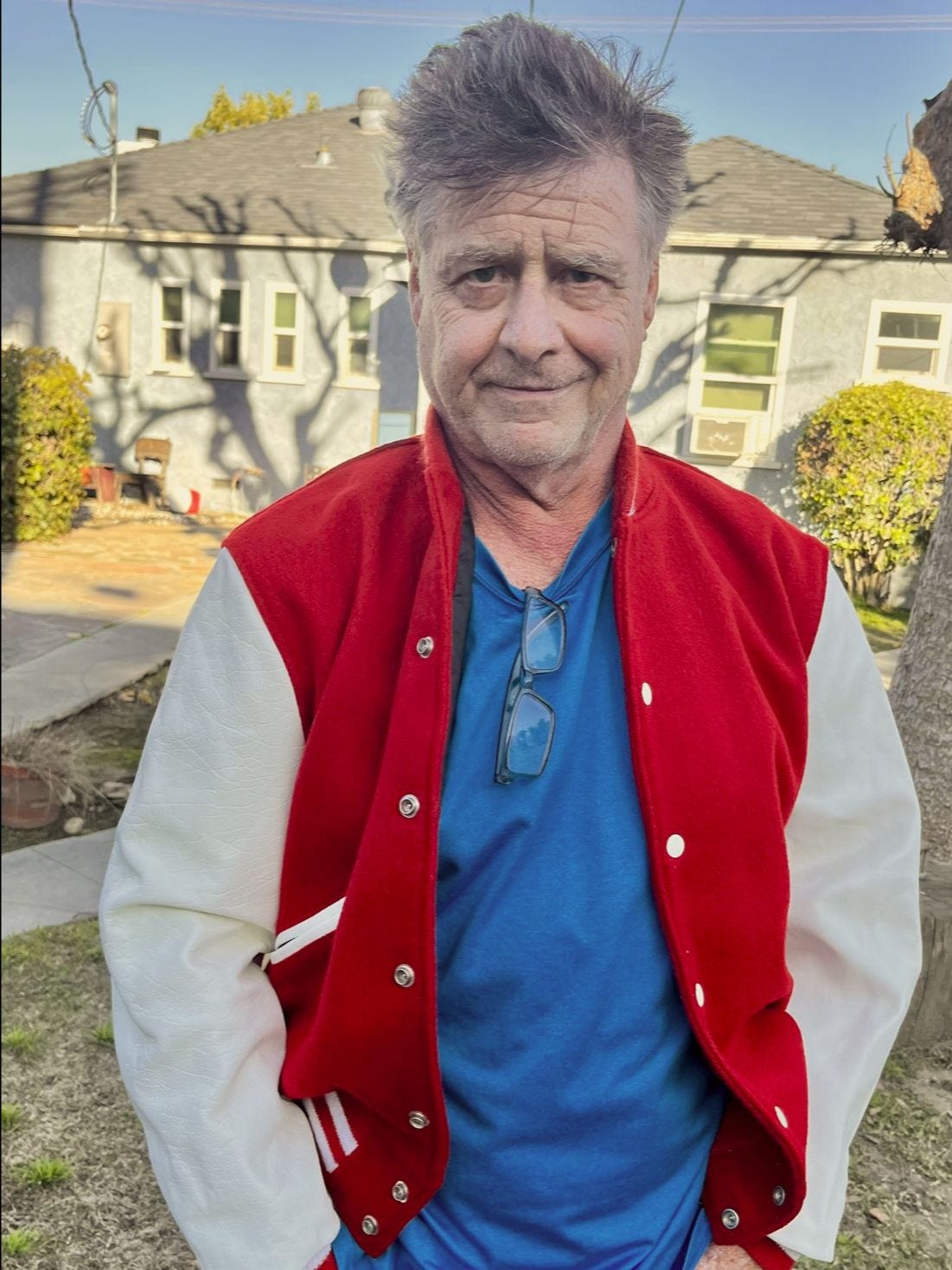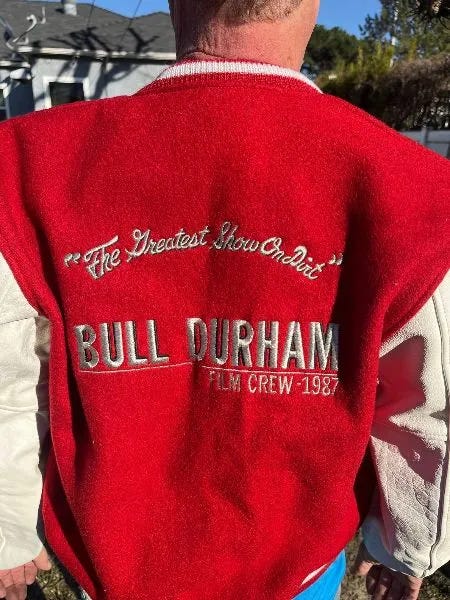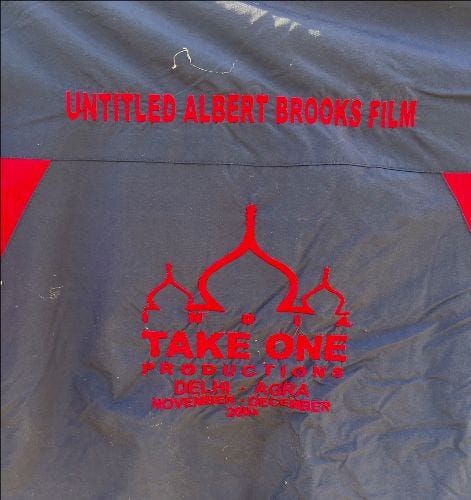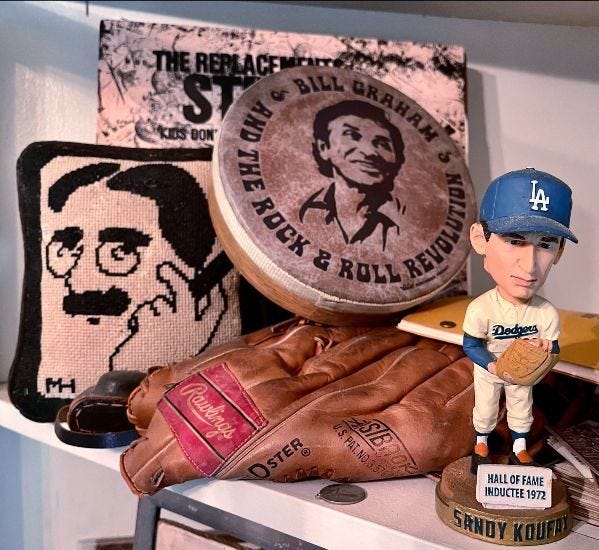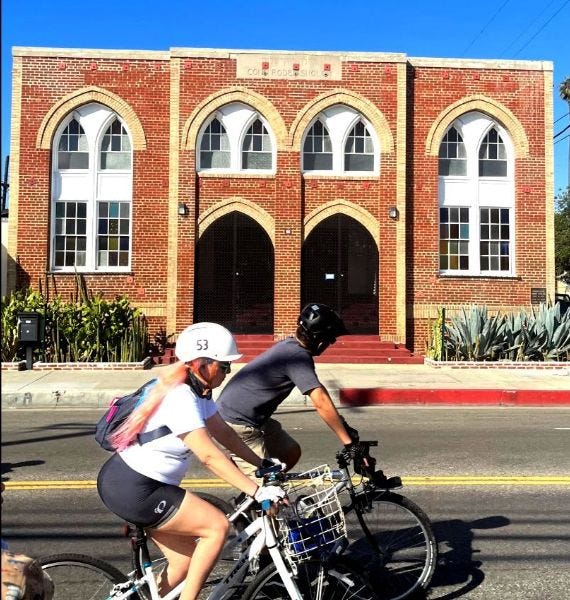Trying On Hollywood
A New Scroll of LA Jewish News
Folks,
In this weekend of the Academy Awards, the poster designed by Saul Bass for the 1960 movie “Exodus,” cuts in so many unexpected ways. If you are as worried about our country as I am, an exodus to calmer, less despotic shores, may have crossed your mind. More disturbing, though the movie was about the armed struggle to found the State of Israel, in this moment of anti-Israel rhetoric, and antisemitic action, for many in the US, the fiery word “EXODUS,” on the poster, could easily be swapped out for the word “GAZA,” or “PALESTINE.” For our president, the gold-tinged “EXODUS” might even seem like a nice travel poster he could hang in the lobby of a new Trump Gaza Hotel. Yet, despite these new meanings and context, as I unfolded the poster today to take a photo, it gave me an unexpected much-needed charge. The fire still burns, and the struggle continues.
…A CALL to those readers who have yet to become paid subscribers, or who need to re-subscribe: It’s very simple, if you continue to read MegilLA, please continue your support. I need your help to continue publishing. Please SUBSCRIBE today.
Shabbat Shalom.
Edmon J. Rodman
////\/\\\\
////\/\\\\
Trying on Hollywood
One jacket at a time
Seth Marten shows a crew jacket from his collection.
Edmon J. Rodman
This week, watching the Academy Awards allows us to witness the drama of film history in the making. For some viewers, though, watching an awards show is not enough. They want a piece of Hollywood, something that can bring back the memories and feelings that connects them to a favorite film. For those fans, a movie crew jacket is a perfect fit.
To feel literally wrapped up in the history of Hollywood, they go to their closet, and like a sports fan getting ready to go to the big game, put on a jacket with an image, logo, or title of their favorite film.
Seth Marten, a Valley resident, who has collected and sold movie crew jackets for decades, knows the feeling well. “Crew jackets are unique, they are historic,” he said in a recent interview. They are specifically made and given only to the cast and crew of the production.”
A collector since he was 10, Marten grew up in a Jewish family with three brothers in Larchmont, New York in Westchester County. Nudging him in the direction of film history, was nearby Mamaroneck, New York, an early center of moviemaking.
“My mother, Jacqueline Marten wrote 20 romantic novels,” he said. His father, Albert Marten, was born on Coney Island, and knew Nathan Handwerker, who started Nathan’s Famous hot dog stand, and his son Murray who expanded the business.
Marten studied journalism and political science at NYU, graduating in 1979. Around that time, buying and selling baseball cards was the rage, and that is when he got his first taste of the collectibles business.
“I didn’t throw away my baseball cards. I kept them in cigar boxes, in nice condition. I took a box to a card convention to sell, and came home with $1200,” he said. “That’s how I supported myself while I was trying to become an actor.”
In 1987, Marten and his wife April, a school teacher, moved to Los Angeles arriving “the night before the Whittier earthquake,” he said, remembering the first-time sensation of the earth moving beneath his feet.
Though acting didn’t pan out, he was hired by producer Bob Weiss as production assistant on the “The Naked Gun,” movies. “I have two crew jackets from those,” he said.
After moving to LA, Marten decided to collect things that were native to California. In the Recycler, he found a “Bull Durham” jacket, and bought it for $50. “I was hooked,” he said.
To build his collection, he scoured yard and garage sales, and flea markets.
Marten estimates that about half the people who are originally issued the jackets wear them, and the other half “throw them in the back of the closet, and sell them later.”
At a Christmas Sale at a shop on Ventura Boulevard, he discovered the crew jackets of Steve Sichel, which decades later continue to sell on eBay.
In the 90s, he sold his first jacket on eBay.
Like many serious collectors, he is picky about what he collects. He doesn’t want anything that was mass produced and made for the retail market. Over the decades, styles have changed and budgets have shifted from expensive styles that resemble letterman jackets to satin and nylon jackets which were popular in the 70s and 80s.
Today, Marten has over 200 items for sale on eBay, including jackets, caps, memorabilia, and art. Though he loves anything with a sports connection, his favorite after the “Bull Durham” piece is a jacket from the 1974 hit “Godfather II.”
As for films with a Jewish connection, “a lot of people ask me about ‘The Big Lebowski,’” he said, though he currently doesn’t have anything from the cult film. Others include a jacket from the production of “The Natural,” which Marten reminded was originally a novel by Bernard Malamud, “The Buddy System,” starring Richard Dreyfuss, and anything from an Albert Brooks film.
Some of the jackets have quirks, and Marten, with the ease of a curator, can explain them. For instance, his jacket, from the 2005 Brook’s comedy “Looking for Comedy in the Muslim World,” was made without the film’s title on it, so cast and crew, according to Marten, could wear it on location without causing a problem.
In stock at his online store, he also has a cast and crew jacket from Steven Spielberg’s “Jurassic Park,” and a handmade pillow with the likeness of Groucho Marx, he said, humming a few bars from Groucho’s classic “Hello, I Must Be Going.”
Driving his own need to collect and his customers' desires as well, he feels, “is a love of movies and TV,” he said.
“We all have an intimate connection to movies. If you have that connection,” he said, “a jacket from the set is a living breathing organic item.”
Find Seth’s pieces of film history on eBay HERE, or contact him at sethroe@sbcglobal.net.
////\/\\\\
GUIDE FOR THE JEWPLEXED:
5 Things
I Didn't Want to Do
Edmon J. Rodman
Since Elon Musk issued an edict that all federal employees submit five things they accomplished in the last week or face getting canned, I have been thinking about a Jewish response. In preparing my list, I wondered if the Rav of Tesla had consulted Rabbi Tarfon’s wisdom found in Pirkei Avot, Ethics of the Fathers, which states: "The day is short, the work is great, the workers are lazy, the reward is great, and the Master of the house is insistent"? Either way, Reb Rocket’s request warrants a serious Talmudic answer. So, representing my own humble fatherly ethic, I present my list of Five Things I Wish I Didn’t Do This Week:
One
As it is said, though the day is short, it did seem longer than usual as I worried that as a result of the chaos in the marketplace, our retirement investments would soon drop to zero.
Two
The world, it is said, stands on three things, and surely one of them must be memory, as I strained to remember, because of the outbreak in Texas, if I had been inoculated for measles.
Three
Since I had, as the rabbis taught us, acquired a gardener, a teacher learned in all things green, I grew concerned when he was hours late to his appointed rounds. Had he been wrongfully detained? I nervously paced and paced, and then I heard the awakening call of his mower.
Four
Though the sages tell us that one who makes unworthy use of the crown will pass away, I wondered if I could wait four years, as I anxiously researched how to move to New Zealand.
Five
Heeding the words of the wise ones who used to say despise lordship and do not become familiar with the government, I quietly edited out the line in the Prayer for Our Country that asks for God’s blessings for our country’s leader. I prayed instead for blessings for our country’s people, who need them now more than ever.
////\/\\\\
Wheeling into shul
A recent CicLAvia event that allowed participants to cycle, walk, or roll through West Adams, Jefferson Park and University Park neighborhoods, via Jefferson Boulevard, had the added benefit of exposing them to a piece of LA Jewish history.
On the route is the former home of synagogue Rodef Shalom located at 2003 W. Jefferson Boulevard. The brick building, as documented in the B'nai B’rith Messenger, housed the congregation from around 1924 (a building plaque gives a date of 1928) until the mid-1940’s, when they moved to a south Fairfax location near Pico.
The synagogue had a Hebrew school and choir, both under the direction of Cantor Isaac Schiff.
The building, which became a church, today houses the studio of contemporary artist Calvin Marcus.
////\/\\\\
*Live from the Archive:
Awash in Hollywood props
Edmon J. Rodman
The copper laver, ritual hand-washer, shown above, illustrates the difficulty of collecting vintage or even antique artifacts in a city that for over one hundred years has been home to the motion picture and television industries.
Though the laver has a dark patina and antique-looking Hebrew script (the blessing for hand washing), making the double-handled cup look ancient, it was made by a Hollywood prop house, probably in the 1970s.
One can imagine the cup being used in a Bible drama, and the applied patina may have kept the reflection of the studio lights from stealing the scene.
Giving away the cup’s origins are the words “cinema props” written on the laver’s bottom with an electric engraving tool.
Founded in Los Angeles in 1921 to serve the city’s growing film business, the Cinema Props Company was started by two Jewish men, Adolph Fleishman and Abraham Cohen.
Like many of Hollywood’s earliest Jewish players who had other careers before coming to the movies, Fleishman, who was from Germany, worked for firm of Hellman, Haas & Company as a bookkeeper in the 1880's. Cohen, who came to the US from Lithuania, was previously a retail furniture merchant.
The merging of their skills in accounting, and in inventory, proved useful in forming a successful film prop rental business.
Prop Services was in business for over 50 years.
*The Rodman Archive of Los Angeles Jewish History is a collection of approximately 1500 objects, photos, clothing, art, books, recordings, and ephemera relating to the lives and endeavors of Jewish Angelenos between 1850 and 1980.
////\/\\\\
Seen on the way: Hollywood
The history of Hollywood plays all around us, and the admission is mostly free. The Lasky-DeMille Barn, (located in a parking lot across from the Hollywood Bowl) now the Hollywood Heritage Museum, was originally a horse barn owned by Jacob Stern, a Jewish businessman who built the Hollywood Plaza Hotel. The barn, first located on the southeast corner of Selma and Vine Streets, was used to house horses and carriages. In 1903, Stern purchased the barn, and in 1912 Harry Revier and LL Burns leased the barn and converted it into a film studio and lab. In 1913, Jesse Lasky, who grew up in a Jewish family in San Francisco, and Cecil B. DeMille, rented the barn to shoot “The Squaw Man,” the first motion picture made in Hollywood. As a result of the influx of Jews who were attracted to the new entertainment business, fewer than 10 years later, in 1920, Hollywood Temple Beth El began holding services.
////\/\\\\






